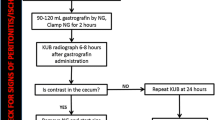Abstract
Foreign body impaction in the esophagus is an important emergency that carries significant morbidity and potential mortality. The most common cause of esophageal foreign body obstruction in adults is meat bolus impaction above a pre-existing distal esophageal (mucosal) ring, peptic or malignant esophageal stricture, or eosinophilic esophagitis. Immediate evaluation of the airway, assessment of the urgency of removal, radiological evaluation to localize the object, endoscopic or surgical retrieval, and subsequent monitoring for complications are essential steps in the management.


Similar content being viewed by others
References
Papers of particular interest, published recently, have been highlighted as •• Of major importance
Webb WA. Management of foreign bodies of the upper gastrointestinal tract: update. Gastrointest Endosc. 1995;41:39–50.
Diniz LO, Towbin AJ. Causes of esophageal food bolus impaction in the pediatric population. Dig Dis Sci. 2012;57:690–3.
Kirchner GI, Zuber-Jerger I, Endlicher E, Gelbmann C, Ott C, Ruemmele P, et al. Causes of bolus impaction in the esophagus. Surg Endosc. 2011;25(10):3170–4. Epub 2011 Apr 13.
•• Sperry SL, Crockett SD, Miller CB, Shaheen NJ, Dellon ES. Esophageal foreign-body impactions: epidemiology, time trends, and the impact of the increasing prevalence of eosinophilic esophagitis. Gastrointest Endosc. 2011;74(5):985–91. Epub 2011 Sep 1. In this study, the increasing eosinophilic esophagitis prevalence only partially explained the increased number of endoscopies performed for food impactions. However, since only a minority of patients underwent biopsies, the true incidence of eosinophilic esophagitis might have been substantially underestimated, thus emphasizing the importance of obtaining biopsies in this setting.
Li Z-S, Sun Z-X, Zou D-W, Xu G-M, Wu R-P, Liao Z. Endoscopic management of foreign bodies in the upper-GI tract: experience with 1088 cases in China. Gastrointest Endosc. 2006;64:485–92.
Larsson H, Bergquist H, Bove M. The incidence of esophageal bolus impaction: is there a seasonal variation? Otolaryngol Head Neck Surg. 2011;144(2):186–90. doi:10.1177/0194599810392655.
Harlor EJ, Lindemann TL, Kennedy TL. Outdoor grilling hazard: wire bristle esophageal foreign body-a report of six cases. Laryngoscope. 2012;122:2216–8.
•• Crockett SD, Sperry SL, Miller CB, Shaheen NJ, Dellon ES. Emergency care of esophageal foreign body impactions: timing, treatment modalities, and resource utilization. Dis Esophagus. 2012. [Epub ahead of print]. This retrospective study looked at the predictive risk factors that were associated with esophageal foreign body impactions in 316 cases. The authors determined that the risk of complications was increased with longer duration of impaction, bone type, and larger bolus size.
Eisen GM, Baron TH, Dominitz JA, et al. Guideline for the management of ingested foreign bodies. Gastrointest Endosc. 2002;55:802–6.
Sung SH, Jeon SW, Son HS, Kim SK, Jung MK, Cho CM, et al. Factors predictive of risk for complications in patients with oesophageal foreign bodies. Dig Liver Dis. 2011;43(8):632–5. Epub 2011 Apr 3.
Pinto A, Muzj C, Gagliardi N, Pinto F, Setola FR, Scaglione M, et al. Role of imaging in the assessment of impacted foreign bodies in the hypopharynx and cervical esophagus. Semin Ultrasound CT MR. 2012;33:463–70.
McNeill MB, Sperry SL, Crockett SD, Miller CB, Shaheen NJ, Dellon ES. Epidemiology and management of oesophageal coin impaction in children. Dig Liver Dis. 2012;44(6):482–6. Epub 2012 Feb 9.
•• Leopard D, Fishpool S, Winter S. The management of oesophageal soft food bolus obstruction: a systematic review. Ann R Coll Surg Engl. 2011;93(6):441–4. This systematic review of the management of esophageal soft food bolus obstructions failed to show that any medical intervention was more effective than a “watch and wait” approach (spontaneous disimpaction). Surgical removal was effective and involved risk but, if done within 24 h, could prevent complications deriving from the initial obstruction.
Weant KA, Weant MP. Safety and efficacy of glucagon for the relief of acute esophageal food impaction. Am J Health Syst Pharm. 2012;69:573–7.
Desai TK, Stecevic V, Chang CH, et al. Association of eosinophilic inflammation with esophageal food impaction in adults. Gastrointest Endosc. 2005;61:795–801.
Chen T, Wu HF, Shi Q, Zhou PH, Chen SY, Xu MD, et al. Endoscopic management of impacted esophageal foreign bodies. Dis Esophagus. 2012 Sep 13. [Epub ahead of print].
Wu WT, Chiu CT, Kuo CJ, Lin CJ, Chu YY, Tsou YK, et al. Endoscopic management of suspected esophageal foreign body in adults. Dis Esophagus. 2011;24(3):131–7. doi:10.1111/j.1442-2050.2010.01116.x. Epub 2010 Oct 13.
Bounds BC. Endoscopic Retrieval Devices. Tech Gastrointest Endosc. 2006;8:16–21.
Schmidt SC, Strauch S, Rösch T, Veltzke-Schlieker W, Jonas S, Pratschke J, et al. Management of esophageal perforations. Surg Endosc. 2010;24:2809–13.
van Heel NC, Haringsma J, Spaander MC, Bruno MJ, Kuipers EJ. Short-term esophageal stenting in the management of benign perforations. Am J Gastroenterol. 2010;105:1515–20.
Vallböhmer D, Hölscher AH, Hölscher M, Bludau M, Gutschow C, Stippel D, et al. Options in the management of esophageal perforation: analysis over a 12-year period. Dis Esophagus. 2010;23:185–90.
Disclosure
No potential conflicts of interest relevant to this article were reported.
Author information
Authors and Affiliations
Corresponding author
Additional information
This article is part of the Topical Collection on Esophagus
Rights and permissions
About this article
Cite this article
Triadafilopoulos, G., Roorda, A. & Akiyama, J. Update on Foreign Bodies in the Esophagus: Diagnosis and Management. Curr Gastroenterol Rep 15, 317 (2013). https://doi.org/10.1007/s11894-013-0317-5
Published:
DOI: https://doi.org/10.1007/s11894-013-0317-5




